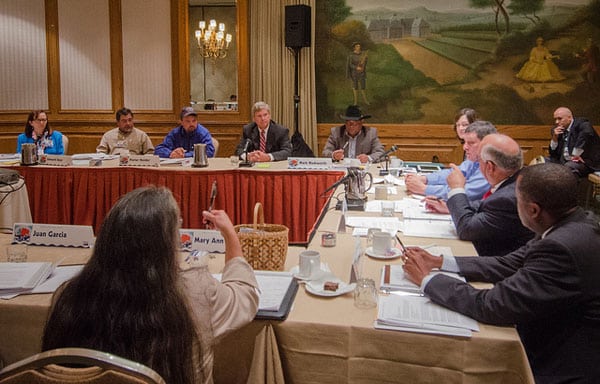
August 16, 2018; Indian Country Today
Last week, NPQ profiled the formation of the Native American Agriculture Fund (NAAF). With $266 million in assets, the NAAF will now be the largest philanthropic organization solely devoted to serving American Indians.
The creation of a new fund dedicated to benefit Native American farmers and ranchers in Indian Country is a positive development, but the tale of the fund’s creation exemplifies the notion that “justice delayed is justice denied.” In 1999, George and Marilyn Keepseagle, both Standing Rock Sioux, filed a case that hundreds of other American Indian farmers would later join charging the US Department of Agriculture with engaging in systemic discrimination against American Indian farmers. The $680-million settlement reached in Keepseagle v. Vilsack (along with an additional $80 million in debt relief) was, writes Vincent Schilling of Indian County Today, a landmark case.
But the settlement was not reached until November 2010, and distributing the funds proved complicated, as claims for money required a detailed application in which “harm” had to be documented. Ultimately, 3,600 American Indian farmers and ranchers had their claims approved, but after they were paid, hundreds of millions remained. It had been expected that 10,000 or more American Indian farmers would file claims, but the actual numbers proved far lower.
So why did 10,000 claimants become 3,600? An article last March in Indianz.com explains:
Even though the case drew significant attention in Indian Country, only about 5,100 farmers and ranchers submitted claims, or about half of the expected number. And of those who applied, only about 3,600 qualified for the settlement, again far less than anticipated.
Even of those who qualified, not all were able to submit documentation to secure larger payments from the settlements, which was divided into two tracks, the latter of which required additional evidence to show direct harm experienced at the hands of the USDA.
Sign up for our free newsletters
Subscribe to NPQ's newsletters to have our top stories delivered directly to your inbox.
By signing up, you agree to our privacy policy and terms of use, and to receive messages from NPQ and our partners.
So after an initial round of $300 million in payments went out, some $380 [million] remained in the settlement.
Also, as Steven Hsu of the Washington Post noted, a “failure to keep records of applicants who previously were denied loans and were eligible for a settlement, a history of skepticism in Indian Country about federal promises, and the difficulty in reaching poor and isolated Native Americans in remote areas to identify wronged parties and make them aware of the settlement” all contributed to reducing the total number of beneficiaries.
What followed was five years of haggling over the remaining $380 million. Schilling notes that this was a cy près proceeding. Cy près, as NPQ has covered before, means “as near as possible.” As a Cornell law site explains, “Practically, this means that the court rewrites the charitable gift or trust so that it is no longer impossible or impracticable to carry out.”
Of course, how best to “make good” on the original intent of the settlement was not obvious. Some wanted to simply distribute the remaining $380 million to the 3,600 successful claimants (i.e., increase their payments), some wanted to distribute the money to nonprofits, and some wanted to create a new foundation.
Ultimately, the compromise reached involved the following split:
- Nonprofits: $38 million. (A list of nonprofits receiving funds is here.) According to Philanthropy and News Digest, the recipients of these funds are all “nonprofits or tribal government agencies that had provided, prior to November 1, 2010, business assistance, agricultural education, technical support, or advocacy services to Native American farmers or ranchers to support and promote their continued engagement in agriculture…. A large number of the awards will support infrastructure or equipment purchases—ranging from irrigation projects, to the purchase of large farm equipment, to the construction of facilities needed to link producers to markets—while others will underwrite the cost of technical assistance or training.”
- Original claimants: $76 million. The 3,600 claimants who made it through the initial approval process gauntlet will each get a tax-free grant of $18,500, with an additional $2,775 sent to the IRS to cover their tax obligations for them.
- New foundation: $266 million. This is the new Native American Agriculture Fund. Its mission is “to fund the provision of business assistance, agricultural education, technical support, and advocacy services to Native American farmers and ranchers to support and promote their continued engagement in agriculture.”
The Court approved the appointment of 14 trustees and an executive director, Janie Hipp, a highly respected lawyer who has specialized in agricultural and American Indian law. The 14 trustees, who are listed by name and tribal affiliation in Schilling’s article, represent a broad cross-section of leaders from a number of American Indian nations.
Eligible grantees, Schilling notes, will include “tax exempt organizations described in section 501c3 of the Internal Revenue Code; educational organizations; Community Development Financial Institutions that are also 501c3 organizations; and instrumentalities of federal or state recognized tribes that furnish assistance designed to further Native farming and ranching.”—Steve Dubb













